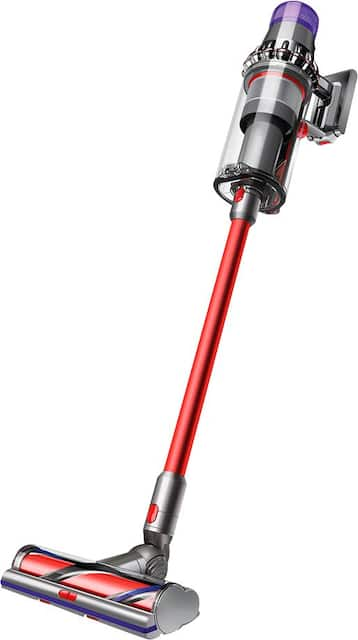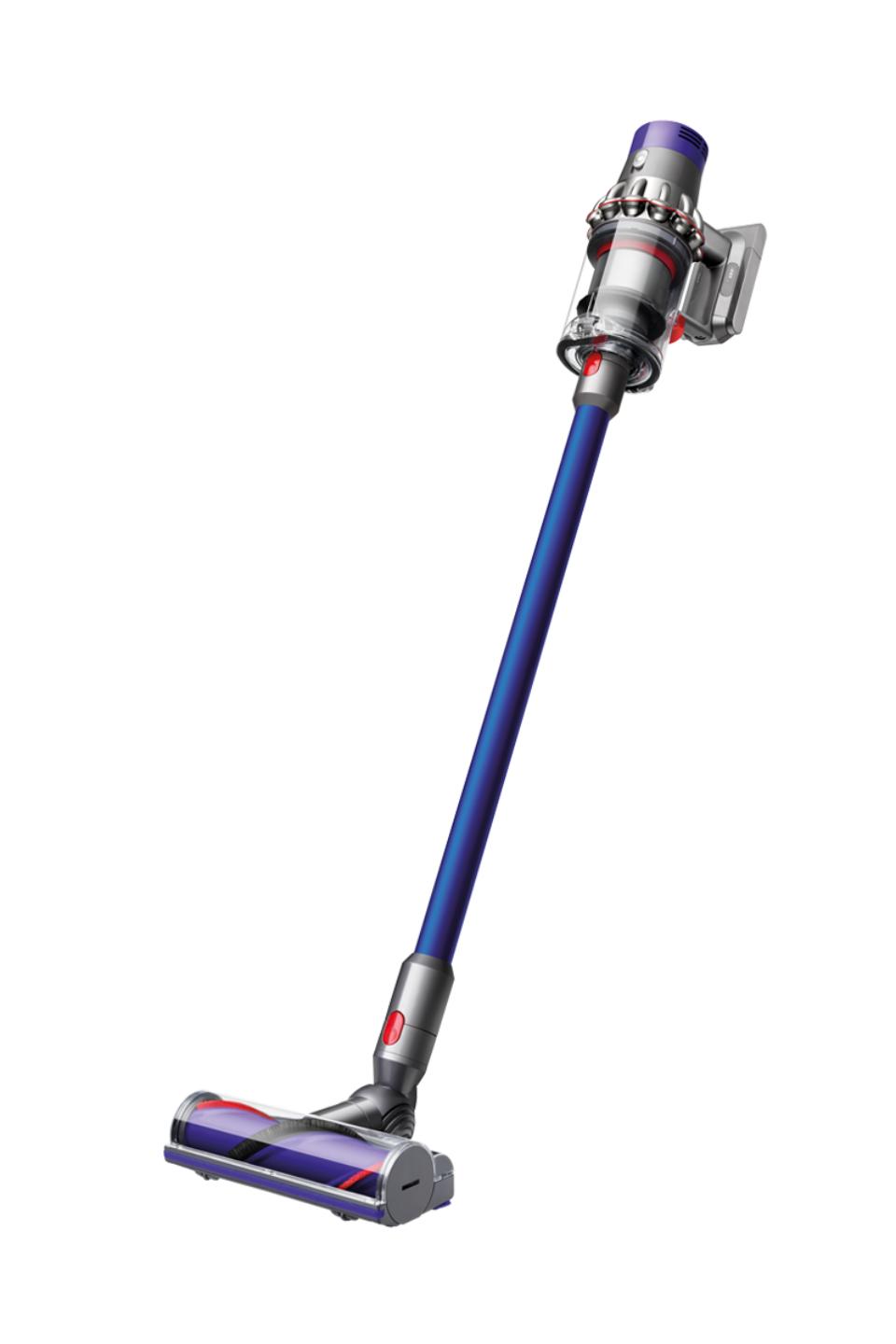Dyson – V11 Outsize Cordless Vacuum – Red/Nickel
Dyson’s most powerful, intelligent cordless vacuum with twice the suction of any cord-free vacuum¹. Now with full-size bin and full-size cleaner head for full-size cleaning, without the cord.
Dyson’s most powerful, intelligent cordless vacuum
Now with full-size bin and full-size cleaner head.
Engineered for whole-home, deep cleaning
Suction power, runtime, and tools designed to deep clean your whole home.
Full-size bin, full-size cleaner head
Covers more floor with each pass. 150% bigger bin than the Dyson V11 Torque Drive for longer cleans between emptying.
Intelligently optimizes suction and runtime across all floor types
The Dyson DLS™ technology automatically senses and adapts to changes in floor type to extend runtime. The right balance of power and runtime when you need it.
LCD screen displays runtime and performance
The digital display shows runtime countdown to the second and displays maintenance alerts, giving you complete control of your clean.
Efficient suction¹
85% more suction than the Dyson V7™ vacuum.
Up to 120 minutes of runtime²
Dyson’s only vacuum with two batteries for extended cleaning.
High-torque XL cleaner head
25% larger than the high-torque cleaner head to cover more of your home, faster. Automatically adapts suction and power to deep clean different floor types without changing cleaner heads.
Advanced whole-machine filtration
Traps most of particles, dust, and allergens as small as 0.3 microns.
Engineered for larger homes with pets.
5 Dyson engineered tools for versatile whole-home and car cleaning
Including the mini motorized tool for removing pet hair from upholstery and tight spaces.
Converts to a handheld for cleaning cars, stairs, and upholstery.
14-cyclone concentric array
The cyclones generate centrifugal forces up to 79,000g trapping fine dust and dirt in the bin, so your vacuum never loses suction.
¹ Tested at the cleaner head to ASTM F558, dust-loaded.
² Runtime based on consecutive use of two battery packs. Actual runtime will vary based on power mode, floor type, and/or attachments used.
Additional information
| Product Height | 50 inches |
|---|---|
| Product Length | 11.7 inches |
| Product Width | 12.5 inches |
| Warranty | 2 Years |






by Sparky
Love it. Had a smaller one but like the big one better you should make it in pink hot pink that is.
by Emiliano
The Dyson 11 Outsize improves over the other V11 models in having a larger bin and it now has removable batteries.
While previous models required a screwdriver to swap batteries, this model finally comes with swappable batteries (Like a power drill). It comes with two identical batteries and two identical power chargers. The battery can be charged in or out of the vacuum, and with the two chargers, both batteries can be charged at the same time.
The larger dustbin, while doesn’t require emptying the vacuum as often, also makes an already large and heavy vacuum even more so.
Performance:
The vacuum engine is really amazing and very powerful. So much so that the vacuum has three speeds, and most times one would use it in either Eco or Med/Auto modes, or about half power or so. The Boost mode runs the battery fairly quickly, it’s much louder and I found it mostly unnecessary, while making the vacuum heavier. In Boost mode this vacuum should exceed the suction power of most wired household vacuums.
The Med mode changes to ‘Auto’ mode when attaching the cleaner head, which senses the type of floor in use, and adapts its speed and the vacuum speed accordingly. If found this to work fairly well when going from hardwood to an area rug or floormats.
Battery:
Comes with two swappable batteries, 7-cell each. In Med/Auto mode, each battery provides from 30 min to 45 min runtime and 1 hour or mode in Eco. The runtime in Boost mode would be around 10 minutes. On a couple occasions, after continuous use, the battery went into protection mode and shut down for a few seconds. If this happens, wait 5 to 10 seconds and everything goes back to normal.
The battery can be charged in or outside the vacuum and has a charging indicator LED, in addition to the screen of the vacuum. It comes with two identical chargers which do no have any lights on them.
Cleaning:
– Hardwood: This is where this vacuum shines. It has plenty of power and about 2 hours of use (2 batteries – In Eco mode) is more than enough runtime. The ‘High Torque’ cleaning head works well: It has two sets of bristles. The softer is slightly longer and is used on hardwood. The firmer set of bristles are shorted and get in contact with rugs.
– Floor mats (or thick, shallow rugs): Using the ‘High Torque’ head works very well, and the Auto sense feature adjusts suction speed very well.
– Rugs: Using the ‘High Torque’ cleaning head works fine on thin or worn rugs, but fails to work at all on slightly thicker area rugs: While the vacuum has plenty of suction, the roller is driven by an independent motor housed inside the roller. It either doesn’t have enough power to push the larger roller or it falsely senses that it’s stuck and stops rotating. This works a bit better when setting the feet of the roller in less suction mode, and at the same time, setting the vacuum in eco mode. What it does is to let more air in, so it doesn’t create too much suction. It’s slightly better but it still gets stuck, and unlike other vacuums, I cannot recommend this for cleaning thicker rugs.
– Upholstery: This model comes with a smaller roll, that’s also independently powered, and it’s great to clean upholstery or car seats.
– Accessories: Plenty of other accessories including a soft brush, a hard brush, a crevices head and a standard head with a retractable brush. This last one would be the go to for almost any cleaning that doesn’t include the powered brushes. All of it can be used with or without the aluminum extension rod.
Dock:
– It comes with a wall-mount dock that requires two screws into the wall, and once mounted, a clip in the dock hides the screws. Unfortunately, this design makes it very hard to try unmounting the dock without breaking it, which can be done with something like a long flat screwdriver and lots of patience. I don’t know why they think this is a good design. If you like me don’t want to make holes into the wall, there is an optional pedestal that like other Dyson products is priced accordingly and costs more than other vacuums.
Emptying and maintenance:
– Really easy by removing the accessories and lifting a lever. Note that unlike previous designs, the barrel can break if one forgets to detach the accessories. This was not a problem on previous designs. This is because the dust comes from the from of the vacuum, where the accessories go. On previous models, it had a separate latch to open the dust bin.
– The rollers have only two sets of bristles to make is harder to catch hair, and the roller can be removed from its enclosure making it easy to clean.
– Most of the vacuum can be taken apart. The dustbin assembly can come off with a series of latches and is very easy to maintain.
– It has a washable cloth filter and a HEPA filter. The HEPA filter is the last in a series of filters and should last from 6 months to a year.
Overall:
– Great suction, swappable batteries would make it an excellent choice. Very long runtime and extra battery. Great assortment of accessories included within. It’s great if you don’t mind the larger size and extra weight. Excellent for hardwood, cleaning cars, upholstery and anything that does not include a thicker rug.
by Harry
Excellent Vacuum, with great suction power. Very easy to use. Does a great job cleaning. Don’t like that I have to hold down the button. EZ fix, I ordered from Amazon a gizmo that takes care of this and give me a locking mode to give the hand a break from holding down the button.
by Chicla
Amazing beautiful machine! It not only luxury, it really gets the job done to perfection! Outstanding quality and performance!
by Hokie
Dyson is getting closer. I own the V6 and the V10. The V11 Oversized is getting closer to ideal for me. The wider brush bar makes it better for larger areas of cleaning. The increased bin size is only natural given the wider brush bar gives you more debris to suck up in one swoop. They’ve even made the battery replaceable. All awesome. I enjoy this vacuum. All our uprights have been retired and we now run strictly cordless stick vacs. Given we have mostly hard floors (tile & wood), this is great for us. The run time has been fantastic so far and the extra battery helps nudge that along if you’re planning to cover a lot of ground. The smart sensing also helps to ensure you’re using power efficiently.
The second battery is included, with a charge cable. Both scores. My gripe though is that it would be next level if they could have somehow integrated charging of the second battery into the wall cradle. As is, you have to leave a battery kind of just sloppily around and hooked up to the cord. Think laptop or smart phone like. Not what I’d expect for how Dyson tends to execute things.
The brush bar still has trouble dealing with larger debris. The suction control ports are too narrow. If they’re going to stick with this design, some arrows or bars in decals to indicate their location would be helpful. I’ll probably just have to make some on my own with our craft machine.
The power level seems to go wonky on me at times. When I go to vacuum an area rug, it kicks into high suction and then the display shows like the battery is running dead. The vacuum will still operate though and if you put it on the charge it shows the battery level is not depleted. See photos.
Overall, I’m very happy and can’t wait to see what the V12 or V13 might do.
by Sergei
Delivery delivered early in the morning by FedEx, as agreed. Thanks!